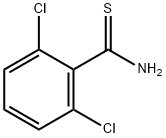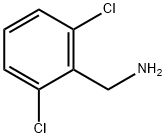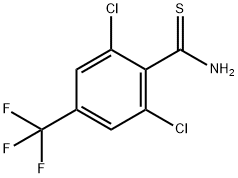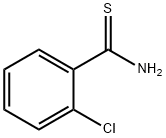2,6-Dichlorothiobenzamide
Synonym(s):2,6-Dichlorobenzenecarbothioamide;2,6-Dichlorothiobenzamide
- CAS NO.:1918-13-4
- Empirical Formula: C7H5Cl2NS
- Molecular Weight: 206.09
- MDL number: MFCD00053523
- EINECS: 217-637-7
- SAFETY DATA SHEET (SDS)
- Update Date: 2024-12-18 14:15:30

What is 2,6-Dichlorothiobenzamide?
Definition
ChEBI: 2,6-dichlorothiobenzamide is a dichlorobenzene and a thiocarboxamide. It has a role as a proherbicide and an agrochemical.
Safety Profile
Poison by ingestion and intraperitoneal route. Moderately toxic by skin contact. Mutation data reported. An herbicide. When heated to decomposition it emits very toxic fumes of Cl-, NOx, and sox.
Metabolic pathway
Twelve metabolites are isolated from either urine or
bile from either rats (11 metabolites) or goats (seven
metabolites) given single oral doses of 14C-labeled
2,6-dichlorobenzonitrile (DCBN). Five of these
metabolites are also excreted in urine from rats dosed
orally with 2,6-dichlorothiobenzamide (DCTBA) which
is an acid amide analog. All metabolites from either DCBN or DCTBA are benzonitriles with the following
ring substituents: Cl2, OH (three isomers); Cl2, (OH)2;
Cl, (OH)2; Cl, OH, SH; Cl, OH, SCH3; SOCH3, OH;
Cl2, S-(N-acetyl)cysteine; Cl, S-(N-acetyl)cysteine; Cl,
OH, S-(N-acetyl)cysteine.
The thiobenzamide moiety of DCTBA is converted
to the nitrile in all extracted urinary metabolites. No
hydrolysis of the nitrile in DCBN to either amide or an
acid is detected. Urine is the major route for excretion;
however, enterohepatic circulation occurs.
Properties of 2,6-Dichlorothiobenzamide
| Melting point: | 151-152°C |
| Boiling point: | 320.6±52.0 °C(Predicted) |
| Density | 1.4704 (rough estimate) |
| refractive index | 1.6300 (estimate) |
| Flash point: | >100 °C |
| storage temp. | -20°C Freezer, Under inert atmosphere |
| solubility | DMSO (Slightly), Methanol (Slightly) |
| form | neat |
| pka | 11.71±0.29(Predicted) |
| color | White to Pale Beige |
| Water Solubility | 0.95g/L(21 ºC) |
| BRN | 1910353 |
| CAS DataBase Reference | 1918-13-4(CAS DataBase Reference) |
| EPA Substance Registry System | Chlorthiamid (1918-13-4) |
Safety information for 2,6-Dichlorothiobenzamide
| Signal word | Warning |
| Pictogram(s) |
 Exclamation Mark Irritant GHS07 |
| GHS Hazard Statements |
H302:Acute toxicity,oral |
| Precautionary Statement Codes |
P264:Wash hands thoroughly after handling. P264:Wash skin thouroughly after handling. P270:Do not eat, drink or smoke when using this product. P301+P312:IF SWALLOWED: call a POISON CENTER or doctor/physician IF you feel unwell. P501:Dispose of contents/container to..… |
Computed Descriptors for 2,6-Dichlorothiobenzamide
New Products
Tert-butyl bis(2-chloroethyl)carbamate (S)-3-Aminobutanenitrile hydrochloride N-Boc-D-alaninol N-BOC-D/L-ALANINOL N-octanoyl benzotriazole 3-Morpholino-1-(4-nitrophenyl)-5,6-dihydropyridin- 2(1H)-one Furan-2,5-Dicarboxylic Acid Tropic acid Fmoc-Val-Cit-PAB DIETHYL AMINOMALONATE HYDROCHLORIDE 1,1’-CARBONYLDIIMIDAZOLE R-2-BENZYLOXY PROPIONIC ACID 1,1’-CARBONYLDI (1,2-4 TRIAZOLE) N-METHYL INDAZOLE-3-CARBOXYLIC ACID (2-Hydroxyphenyl)acetonitrile 4-Bromopyrazole 5-BROMO-2CYANO PYRIDINE 5-broMo-2-chloro-N-cyclopentylpyriMidin-4-aMine 2-(Cyanocyclohexyl)acetic acid 4-methoxy-3,5-dinitropyridine 2-aminopropyl benzoate hydrochloride 1-(4-(aminomethyl)benzyl)urea hydrochloride tert-butyl 4- (ureidomethyl)benzylcarbamate diethyl 2-(2-((tertbutoxycarbonyl)amino) ethyl)malonateRelated products of tetrahydrofuran








You may like
-
 Chlorthiamid CAS 1918-13-4View Details
Chlorthiamid CAS 1918-13-4View Details
1918-13-4 -
 1975-50-4 98%View Details
1975-50-4 98%View Details
1975-50-4 -
 2-HYDROXY BENZYL ALCOHOL 98%View Details
2-HYDROXY BENZYL ALCOHOL 98%View Details
90-01-7 -
 2-Chloro-1,3-Bis(Dimethylamino)Trimethinium Hexafluorophosphate 221615-75-4 98%View Details
2-Chloro-1,3-Bis(Dimethylamino)Trimethinium Hexafluorophosphate 221615-75-4 98%View Details
221615-75-4 -
 61397-56-6 CIS BROMO BENZOATE 98%View Details
61397-56-6 CIS BROMO BENZOATE 98%View Details
61397-56-6 -
 14714-50-2 (2-Hydroxyphenyl)acetonitrile 98+View Details
14714-50-2 (2-Hydroxyphenyl)acetonitrile 98+View Details
14714-50-2 -
 118753-70-1 98+View Details
118753-70-1 98+View Details
118753-70-1 -
 733039-20-8 5-broMo-2-chloro-N-cyclopentylpyriMidin-4-aMine 98+View Details
733039-20-8 5-broMo-2-chloro-N-cyclopentylpyriMidin-4-aMine 98+View Details
733039-20-8